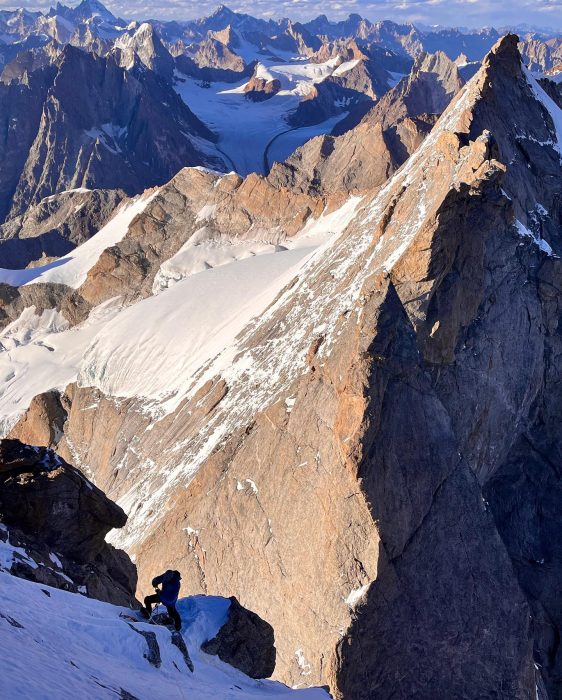A team of American climbers, including Christian Black, Vitaliy Musiyenko, and Hayden Wyatt, has achieved a remarkable feat by successfully opening an 850-meter route on the White Sapphire peak (6,040m) in India’s Kishtwar Valley. This challenging ascent received a grading of 80, AI3, M7+ and stands as a significant achievement in the world of mountaineering.
Exploring the Kishtwar Valley

Musiyenko, through his social media posts, has highlighted the abundance of awe-inspiring peaks in the Kishtwar Valley. He humorously pointed out that the real challenge was not finding a suitable peak to conquer, but deciding which one to tackle. He humorously added, It’s not just about the summit; it’s about the amusing stories you accumulate on the journey, and shared a humorous anecdote about their initial setback due to a malfunctioning stove during their first attempt.
Challenges and Transformations
Before their second successful attempt, the climbers had to overcome a series of challenges. Adverse weather conditions and radical changes in the mountain’s terrain posed significant hurdles. Musiyenko described how the White Sapphire, initially pristine as a diamond, transformed into an ice-covered challenge akin to Cerro Torre due to the arrival of winter.
Details of the Climb | American Climbers
Musiyenko generously shared a detailed account of their two-day climb
Day 1 The Ascent
On October 5th, the climbers commenced their ascent from a high camp at 15,800 feet. They opted for a prominent ice gully to the left of the central buttress, leading to a col. To navigate a vertical, detached water ice pillar and cross the bergschrund, they utilized their climbing skills.
They embarked on a 1,300-foot simul climb, reaching approximately AI3 M3 in difficulty. Intermediate belays with micro-traxion devices on every rope length provided additional safety. They brought six such devices. They carried out two more simul-climbs, covering distances of 650 and 350 feet, with difficulties escalating to AI3 M4+. Two additional pitches at M5 and M6 (240 ft) took them to the col, summing up to 2,540 feet of roped climbing on the first day.
Read More: Lucien Boucansaud’s Solo Pumori Triumph
For the night, they attempted to rest on a massive overhanging cornice at an altitude of 19,100 feet, sleeping in their harnesses and securely tied to an anchor.
Day 2 The Summit
On October 6th, they patiently awaited the sunrise and melted an ample amount of snow, anticipating a demanding day of climbing. They successfully tackled two consecutive M7+ pitches (360 ft), which led to easier terrain. Two more pitches (M4 and M5, covering 380 feet) brought them closer to the summit. A 220-ft pitch of M6 R took them to the base of the summit pyramid, where they encountered an M5-6 boulder problem, eventually reaching the summit ridge and celebrating their achievement. They spent approximately an hour at the summit, taking photographs, sending messages, and documenting their success.
The Descent and Challenges
After leaving the summit, the climbers faced strong winds and plummeting temperatures. The descent involved four full rope rappels, leading them back to the col. They continued their celebration, massaging each other’s feet and melting snow well into the night.
However, their return was challenging, and they reached Advanced Base Camp at sunset. The following day, carrying heavy backpacks, they descended to 13,200 feet. The descent was not without its trials, as both Hayden Wyatt and Musiyenko faced nasty falls while navigating unstable talus with heavy loads. Musiyenko’s leg became trapped under a massive boulder, but his double boot prevented a more severe injury. Hayden came to his rescue, and the Liaison Officer and kitchen staff provided a heartwarming welcome with tea, pizza, and a cake.
Climbing Style and Base Camp
The team achieved their remarkable feat through entirely free-climbing the route, without relying on bolts or aid climbing. The second crux pitch, in particular, presented a formidable challenge, demanding unwavering focus and skill.
The team embraced an alpine climbing style, leaving no ropes or camps behind after their initial attempt. Their base camp was established with the assistance of a cook and a Liaison Officer, while mules transported the loads. From that point, the climbers carried all their equipment and essentials on their backs, minimizing their time spent in base camp.
Funding and Historical Significance
The climbers received support for their 26-day expedition through an $8,000 Cutting Edge grant from the American Alpine Club. Notably, White Sapphire Peak had previously been scaled from the west face by Denis Burdet and Stefan Siegrist of Switzerland in 2012, as documented in the American Alpine Journal. Subsequently, in 2016, a second team reached the summit via the South Ridge, further contributing to the mountain’s climbing history.